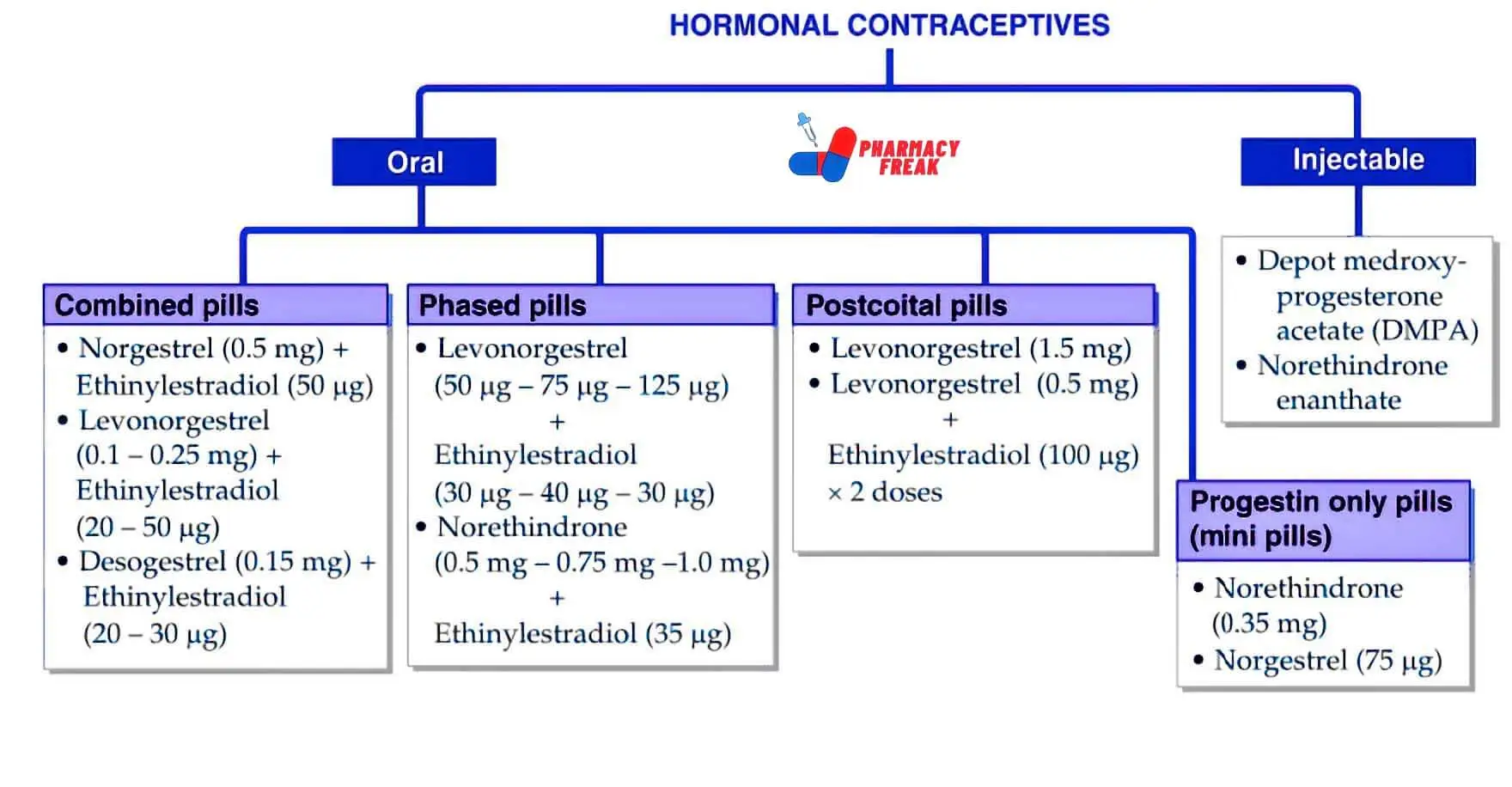Hormonal contraceptives are a category of birth control methods that use synthetic hormones to prevent pregnancy. These contraceptives are highly effective when used correctly. They work by inhibiting ovulation, thickening cervical mucus to prevent sperm from reaching the egg, and thinning the uterine lining to reduce the chances of implantation.
Table of Contents
Here is a classification of hormonal contraceptives.
HORMONAL CONTRACEPTIVES
- Oral-
- Combined pills- Norgestrel (0.5 mg) + Ethinylestradiol (50 μg), Levonorgestrel (0.1-0.25 mg) + Ethinylestradiol (20-50 µg), Desogestrel (0.15 mg) + Ethinylestradiol (20-30 µg)
- Phased pills- Levonorgestrel (50 µg 75 µg 125 µg) + Ethinylestradiol (30 µg 40 µg 30 μg), Norethindrone (0.5 mg 0.75 mg -1.0 mg) + Ethinylestradiol (35 µg)
- Postcoital pills– Levonorgestrel (1.5 mg), Levonorgestrel (0.5 mg) + Ethinylestradiol (100 µg) * 2 doses
- Progestin only pills (mini pills)– Norethindrone (0.35 mg), Norgestrel (75 µg)
- Injectable- Depot medroxy- progesterone acetate (DMPA), Norethindrone enanthate
Combined Hormonal Contraceptives (CHCs)
Contain both estrogen and progestin hormones.
Available in various forms, including:
- Combined Oral Contraceptives (COCs): Birth control pills that must be taken daily.
- Contraceptive Patch: A patch worn on the skin, changed weekly.
- Vaginal Ring: A flexible ring inserted into the vagina, replaced monthly.
Progestin-Only Contraceptives (POCs):
Contain only progestin hormone, making them suitable for women who cannot take estrogen.
Types include:
- Progestin-Only Pills (Mini Pills): Taken daily, typically at the same time each day.
- Depot Medroxyprogesterone Acetate (DMPA): Injectable contraceptive administered every 3 months.
- Progestin Implants: Small rods placed under the skin of the upper arm, providing protection for several years.
- Progestin Intrauterine Device (IUD): A T-shaped device inserted into the uterus, offering long-term contraception.
Emergency Contraceptives
- Used after unprotected sex or contraceptive failure.
- Can be progestin-only (levonorgestrel) or combined (ulipristal acetate).
- Must be taken as soon as possible after unprotected sex for effectiveness.
Long-Acting Reversible Contraceptives (LARCs)
Highly effective and long-lasting contraceptive methods.
Types include:
- Intrauterine Devices (IUDs): Both hormonal and non-hormonal options are available.
- Implants: Small, flexible rods inserted under the skin, providing protection for several years.
Extended Cycle Contraceptives
- Designed to reduce the number of menstrual periods.
- Examples include extended-cycle birth control pills.
Continuous Hormonal Contraceptives
- Aim to eliminate monthly bleeding.
- Examples include contraceptive injections given every 3 months.
Transdermal Contraceptives
- Delivered through the skin.
- Examples include contraceptive patches.
Injectable Contraceptives
- Administered by a healthcare provider.
- Provide protection for several months.
Combination Vaginal Ring
- A form of CHC inserted into the vagina and replaced monthly.
Progestin-Only Pill
Requires daily use and does not contain estrogen.
Birth Control Pills for Breastfeeding Women
Special formulations for women who are breastfeeding.
Birth Control Pills for Perimenopausal Women
Formulated to address the hormonal changes that occur during perimenopause.
Hormonal Contraceptives for Medical Purposes
Some hormonal contraceptives are used for medical conditions such as polycystic ovary syndrome (PCOS), endometriosis, and heavy menstrual bleeding.
Reference
- Classification of Progestins- KD Tripathi
- National Library of Medicine- Contraception: Hormonal contraceptives
Related Links
